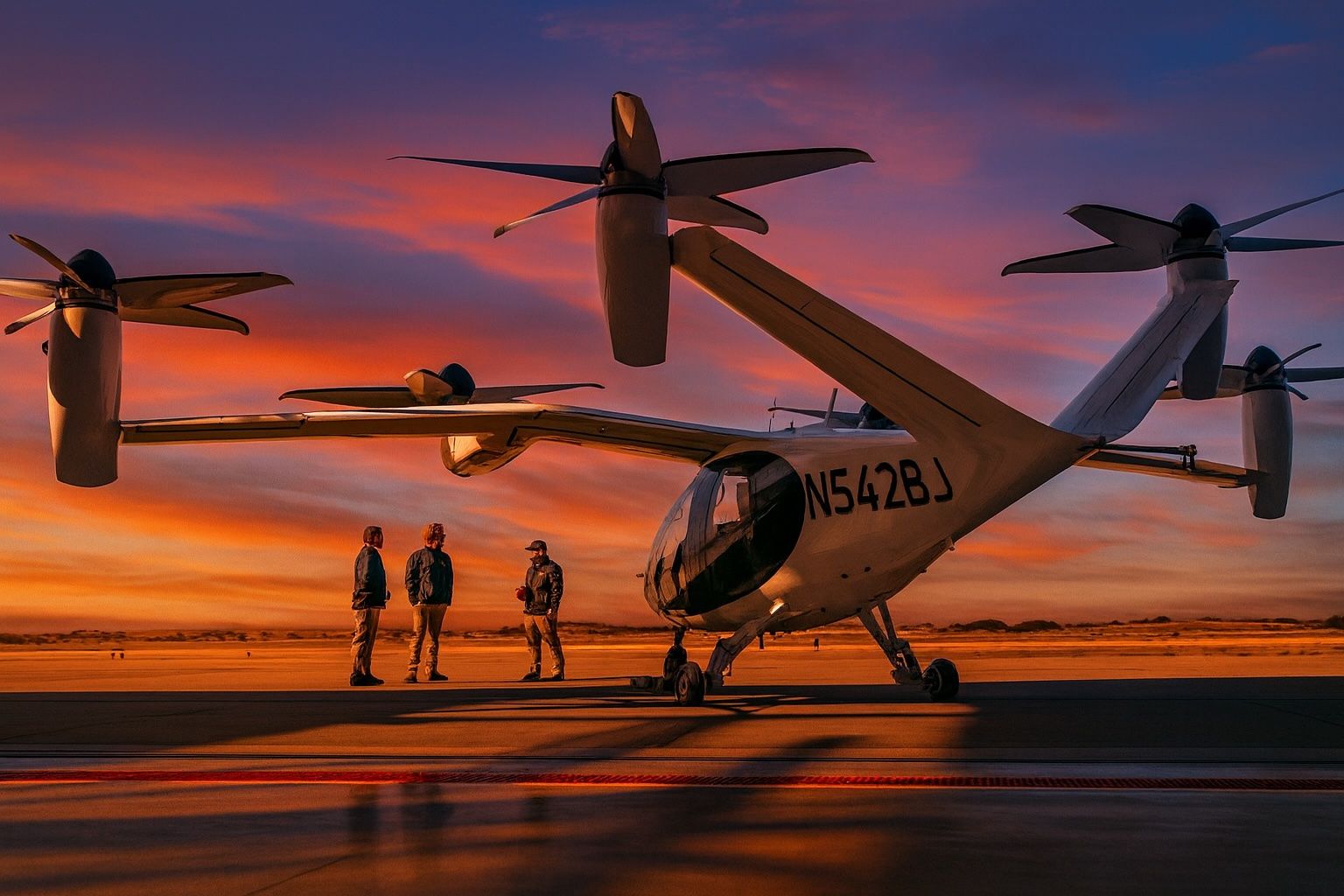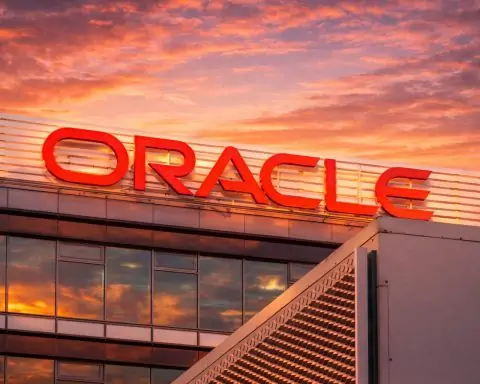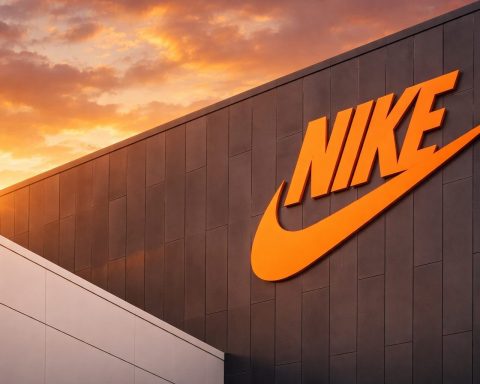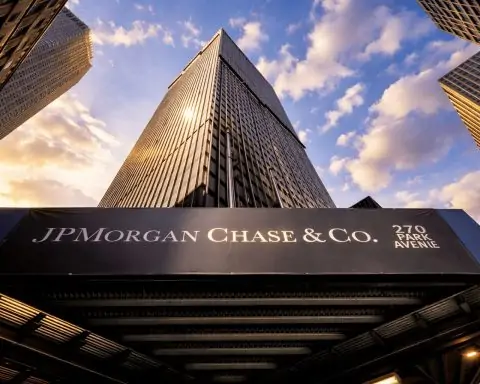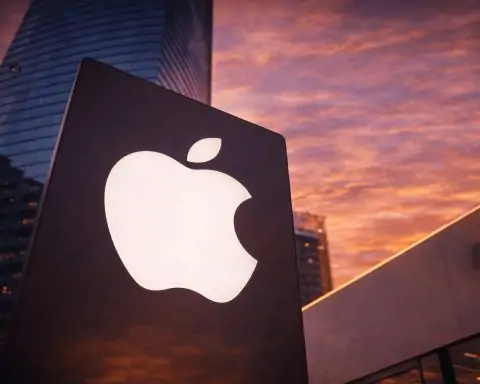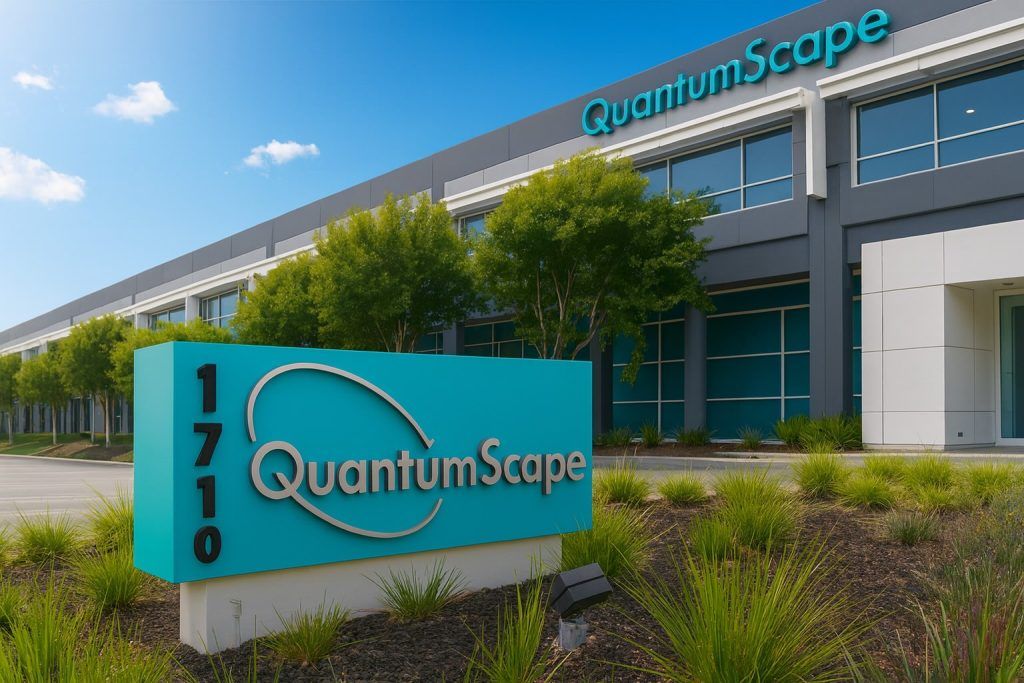- Stock Surge: Joby Aviation’s stock is trading around the high teens (~$18 per share) as of October 6, 2025, after a strong rally in early October. Shares have more than tripled over the past year, climbing from around $5 last fall to recent highs near $20 [1]. In the first week of October alone, the stock jumped roughly 10%, continuing a 234% year-to-date gain driven by momentum in its electric air taxi program [2] [3].
- Recent Deals & Wins:Major 2025 deals include an August acquisition of Blade Air Mobility’s urban air charter business (for up to $125 million) and a partnership with L3Harris to develop a military-grade hybrid eVTOL [4] [5]. In late September, Joby unveiled a UAE partnership (with Skyports and Ras Al Khaimah’s transport authority) to launch air taxi services in the UAE by 2027 [6]. It also conducted public demonstration flights in Japan at Expo 2025 Osaka with partner ANA, marking a world-first showcase of an eVTOL at a global expo [7].
- Regulatory Momentum:Certification efforts are advancing. Joby is ~70% through the FAA’s penultimate certification stage as of Q3 2025 [8], targeting full approval by mid-2026. Regulators are lending support: the FAA’s new Advanced Air Mobility pilot program (launched Sept 2025) will allow limited eVTOL operations on select routes even before full certification [9]. Japan’s regulator (JCAB) is closely collaborating with Joby to craft air taxi rules, and Gulf states are embracing eVTOL initiatives, signaling broad government backing [10] [11].
- Financial Health: Joby remains pre-revenue, with negligible sales (~$20,000 in Q2 2025) and large ongoing losses. Q2 2025 net loss was about $325 million (EPS –$0.41) [12]. The company’s cash reserves are strong at $991 million (bolstered by strategic investments from Toyota) [13]. Joby forecasts a $500–540 million cash burn for full-year 2025, implying it has runway into 2026 [14] [15]. The Q3 2025 earnings call is scheduled for Nov 5, 2025 [16], where investors will watch for updates on spending and certification progress.
- Analyst Sentiment: Despite Joby’s stock rally, Wall Street is cautious. The consensus rating is “Hold” with an average price target around $10.5 – roughly 35-40% below the current price [17] [18]. Price targets range from $7 (JPMorgan) to $17 (Canaccord) [19]. As of early October, most analysts advise holding or waiting given the long road to commercialization, though a few early bulls have recently dialed back optimism in light of execution risks [20] [21].
- Competitive Edge in eVTOL: Joby is a frontrunner in the nascent electric vertical takeoff and landing (eVTOL) air taxi market, aiming for a first-mover advantage in commercial operations. Key rivals include Archer Aviation (targeting FAA approval in 2026 for its 4-passenger Midnight eVTOL) [22], Beta Technologies (Amazon-backed, filed for IPO in Sept 2025, with a hybrid-electric aircraft partnership with GE) [23], Eve Air Mobility (Embraer-backed, projecting a 30,000 eVTOL fleet by 2045) [24] [25], and Lilium (German startup facing delays and financial hurdles) [26]. Unlike some peers pushing autonomy, Joby’s focus is on piloted, quiet air taxis carrying 4 passengers plus pilot, with strong government and partner support in the U.S., Japan, and Middle East [27].
Stock Price & Recent Performance
Joby Aviation’s stock has been on a remarkable upward trajectory in 2025, reflecting growing enthusiasm for its electric air taxi vision. As of the beginning of October 2025, the stock was trading in the high teens ($17–$18 per share) – a dramatic climb from about $5 a year earlier [28]. On October 3, 2025, shares closed around $18.26, capping off a week in which the stock jumped roughly 10% amid positive news flow. Over the past six months, Joby’s share price has gained well over 200%, and it has more than tripled year-over-year, vastly outperforming the broader market [29] [30]. This surge has pushed Joby well above most analyst price targets (near $10), underscoring the bullish market sentiment contrasted with cautious analyst outlooks [31] [32].
Several factors are fueling the rally. Major strategic wins (detailed below) have given investors confidence in Joby’s path to commercialization, and broader interest in the eVTOL space has grown as regulatory barriers begin to inch lower. Trading volume spiked in late September and early October, indicating strong investor interest on news of partnerships and policy support. However, the rapid rise also means the stock carries high expectations – any delays or setbacks in the coming months (e.g. certification hiccups or cash burn concerns) could introduce volatility. For now, momentum is clearly on Joby’s side, with the stock’s upward trend reflecting optimism about its first-mover advantage in the emerging air taxi market [33].
Major 2025 Deals & Partnerships
A series of game-changing deals in 2025 have significantly strengthened Joby’s strategic position:
- Blade Urban Air Mobility Acquisition (August 2025): In a move to secure infrastructure and customers, Joby agreed to acquire Blade Air Mobility’s helicopter and seaplane passenger business for up to $125 million [34]. Blade’s network of city heliport terminals (in New York, Boston, South Florida, etc.) and its ~50,000 annual VIP passengers provide Joby with ready-made vertiports and a customer base for future eVTOL operations [35]. This deal also included plans to integrate Blade’s services into Uber’s app by 2026, effectively piggybacking on Uber’s platform to reach urban travelers [36]. Analysts hailed the Blade acquisition as a “massive de-risking” of Joby’s commercial launch, since it gives the company established routes and terminals ahead of launching its own aircraft service [37].
- Defense Partnership with L3Harris (August 2025): Joby teamed up with defense contractor L3Harris to develop a hybrid electric-military VTOL aircraft based on Joby’s S4 design [38]. L3Harris described Joby’s technology as an “urgently-required innovation” for defense applications [39]. The joint project will add a small gas-turbine generator to extend range, targeting use by the U.S. military. Flight testing of this hybrid prototype is expected by late 2025, with demonstrations in 2026 [40]. This collaboration not only opens a potential new revenue stream in defense (with non-dilutive funding), but also validates Joby’s tech in a demanding use-case. It underscores the versatility of Joby’s aircraft and provides a vote of confidence from a major aerospace player.
- Toyota’s Ongoing Investment: In a show of support from a key strategic partner, Toyota Motor Corporation – already a major investor – executed a second $250 million tranche of its investment in Joby in mid-2025, part of a larger $500 million agreement [41]. In exchange, Toyota received roughly 49.7 million new Joby shares [42]. Toyota’s continued backing is a strong signal of confidence in Joby’s technology and long-term vision, even as the company remains in a development phase. (Toyota is not only investing capital, but also sharing manufacturing know-how as Joby prepares to scale up production.) Notably, Toyota’s support helped offset any negative sentiment from insider selling – for example, a Joby co-founder sold 500,000 shares in Aug 2025 under a pre-planned program, which some observers initially viewed with concern [43]. The Toyota investment helped affirm that major stakeholders remain bullish on Joby’s prospects.
Joby Aviation’s all-electric air taxi prototype (the S4 model) during a test flight. The company’s eVTOL aircraft, designed for a pilot and four passengers, is at the core of its recent partnerships and demonstrations.
- Delta & Uber Partnerships: (Background) In addition to 2025’s new deals, Joby has earlier partnerships laying the groundwork for its service. Notably, Delta Air Lines invested in Joby in 2022 and is collaborating to offer air taxi transfers to airport passengers in the future. Uber is also aligned via the Blade integration and previous agreements – Uber sold its Elevate flying taxi division to Joby in 2020 and plans to integrate Joby’s service into its app. These alliances with established transport giants could provide built-in demand and distribution once Joby’s flights go live. While not new in 2025, these partnerships remain crucial to Joby’s go-to-market strategy and are part of why investors are excited about its network effects.
Global Expansion & Regulatory Progress
Joby isn’t just making deals at home – it’s actively expanding its global footprint and working with regulators to clear a path for its air taxis:
- Japan Public Flight Demonstration (Oct 2025 Expo in Osaka): In a landmark event, Joby and its Japanese partner ANA Holdings conducted the world’s first public eVTOL demonstration flights at a World Expo [44]. Starting October 1, 2025, Joby’s piloted electric air taxi (branded in ANA’s livery) performed daily flight demos at Expo 2025 Osaka, showcasing vertical takeoff, transition to winged flight, and landing [45]. The demonstrations – over 20 flights planned during the 13-day expo – gave 200,000+ daily visitors a firsthand glimpse of an air taxi in action [46]. “Japan has led the world in transforming ground transportation… Now, Japan is poised to lead the world again, this time in the air,” said Joby CEO JoeBen Bevirt during the Expo, highlighting the significance of these flights [47]. ANA’s CEO noted the strong support from national and local governments in Japan to make air taxis a reality [48]. These flights are not just publicity stunts – they are gathering valuable data on airspace integration and public perception, and they help pave the way for regulatory approval in Japan [49]. Japan’s Civil Aviation Bureau (JCAB) is using insights from the demo to develop advanced air mobility regulations, working closely with Joby to potentially launch air taxi services in Japan (starting with a network in Tokyo) in coming years [50] [51].
- United Arab Emirates Partnership (Sept 2025): Joby announced a deal with the Ras Al Khaimah Transport Authority (RAKTA) in the UAE, in partnership with Skyports Infrastructure, to launch commercial air taxi services in Ras Al Khaimah by 2027 [52]. The agreement, signed in late September with local rulers in attendance, is part of the emirate’s 2030 Master Plan for sustainable transport [53]. This move will establish Joby’s presence in the Middle East, a region keen on adopting futuristic transport (neighboring Dubai, for example, has its own air taxi initiatives). It also marks Joby’s first firm international service launch plan. By teaming with Skyports (a vertiport developer) and a government authority, Joby gains both infrastructure support and political backing. The Gulf states’ enthusiasm – highlighted by VIPs at the signing ceremony – indicates a welcoming regulatory environment for eVTOL operations in that region [54]. Like the Japan expo, the UAE partnership builds momentum and secures a market for Joby’s platform years before the service actually begins.
- FAA and U.S. Regulatory Milestones: In its home market, Joby is deeply engaged with the Federal Aviation Administration (FAA) to certify its aircraft and open up routes. As of Q3 2025, Joby reported it is about 70% through “Stage 4” of the FAA type certification process (the final, most intensive design review stage) [55]. The company aims to complete Stage 4 by the end of 2025 and receive full FAA certification by mid-2026, which would allow commercial passenger service in the U.S. [56]. In a positive development, the FAA in September 2025 launched an Advanced Air Mobility (AAM) pilot program to start integrating eVTOLs into existing airspace. This program will permit select routes and operations before full certification is granted [57]. Joby lobbied for this and praised the move, noting it “allows aircraft in the program to begin operations… ahead of full FAA certification” – effectively a early start for limited commercial service [58]. Joby plans to take advantage by initiating crewed test flights from its Marina, California facility and a new vertiport in Texas later in 2025 [59]. Additionally, Joby is working with state and city authorities (e.g. aiming to establish vertiport hubs in California and Florida) to ensure that when its aircraft are certified, the infrastructure and local approvals are in place to commence operations quickly [60].
- Global Regulatory Support: Beyond the U.S. and Japan, other regions are preparing for eVTOL adoption. European regulators (EASA) and the Middle East are crafting frameworks for urban air mobility, often in dialogue with companies like Joby. For instance, the UAE is creating dedicated air corridors for eVTOL test flights [61]. Overall, government support is growing worldwide as officials see potential benefits in reduced traffic congestion and greener transit. This supportive policy environment is crucial for Joby – it must navigate safety and airspace regulations in each market. Thus far, the signs are encouraging: multiple countries are signaling that by 2025-2027 they want to be eVTOL-ready, aligning with Joby’s timeline to launch services.
Financial Health and Q3 2025 Outlook
Joby Aviation remains in a development-stage financial posture, investing heavily in R&D and certification with minimal revenue to show yet. In Q2 2025, the company reported a token revenue of just $20,000 (from a few R&D contracts) [62] – effectively zero operating revenue from air taxi services, which are not yet commercial. Meanwhile, quarterly expenses are massive: the net loss in Q2 2025 was about $325 million [63], slightly wider than the ~$286 million loss a year earlier, as the company continues to ramp up prototype manufacturing, testing, and personnel in preparation for launch. Joby’s loss per share was –$0.41 for Q2, in line with analyst expectations of continued deep losses [64].
The good news is that Joby is well-capitalized for now. As of June 30, 2025, it held $991 million in cash and short-term investments on its balance sheet [65]. This war chest was boosted by strategic investments like Toyota’s $250M infusion in 2025 and earlier capital raises. Joby’s own guidance indicates it will spend about $500–$540 million in cash during 2025 (excluding the Blade deal cost) [66]. At that burn rate, the company has enough cash to last into 2026, even factoring in the costs to reach certification and start initial operations [67]. Importantly, the Blade acquisition, while costly, was structured mostly in stock and future payments, limiting immediate cash outflow.
For the upcoming Q3 2025 results (set to be reported on November 5, 2025), investors do not expect any revenue breakthrough – Joby will likely remain essentially pre-revenue until at least 2024 or 2025 when services formally launch. The focus will instead be on cash burn and milestones. Analysts and shareholders will scrutinize how much cash was used in Q3 (Q2’s burn was ~$112M) [68] and whether management updates its full-year spending forecast. They’ll also listen for progress updates on certification (e.g. any major milestones achieved in Q3) and program development (such as how the Japan demo and other tests went, or any changes in timeline for launch). Given the stock’s strong performance, any signs of delay or budget overruns could impact sentiment. Conversely, reaffirmation of the mid-2026 launch target or new partnerships could further bolster confidence.
Another financial aspect to watch is future funding. With nearly $1 billion in cash, Joby is in a decent position, but as a pre-revenue company, it will eventually need to raise more capital (through equity, debt, or strategic deals) if the cash burn continues into 2026. Management has indicated that current cash should carry the company through initial certification and into the start of commercial operations [69]. If all goes to plan, by the time more funds are needed, Joby might have revenue or at least a clear path to it, which could improve financing terms. In the meantime, the company’s financial health is stable for an early-stage aerospace venture – it has no debt to speak of, and its biggest “liability” is the ongoing spend required to make air taxis a reality. The Q3 and upcoming Q4 2025 reports will be key for the market to gauge whether spending is on track and how far that cash runway can stretch.
Analyst Forecasts and Market Sentiment
Despite the exciting headlines and surging share price, Wall Street analysts remain mostly cautious on Joby as of October 2025. According to MarketBeat and other tracking sources, the consensus rating is a Hold, with 6 analysts covering the stock yielding 1 Buy, 4 Hold, and 1 Sell recommendations [70] [71]. The average 12-month price target is about $10.5 per share, which is roughly 35–40% lower than the current trading price in the high teens [72] [73]. In fact, by early October, Joby’s stock (around $17–$18) had overshot even the highest analyst target on record (Canaccord Genuity’s $17 target) [74] [75]. This disconnect suggests that analysts believe near-term upside is limited unless Joby’s fundamentals (or timeline to revenue) accelerate beyond current expectations.
Some recent analyst actions illustrate the tempered sentiment:
- JPMorgan in August 2025 maintained an Underweight rating (effectively a Sell) and set a $7 price target [76], citing the long road to profitability.
- Canaccord Genuity around the same time upgraded to Hold and issued the above-mentioned $17 target (one of the most optimistic on the street) [77]. Even this bullish case assumes the best-case execution by Joby.
- Cantor Fitzgerald held a Neutral view with a $9 target, and HC Wainwright (once positive on Joby) downgraded from Buy to Neutral by mid-2025 [78].
Analysts often point to significant risks: the company is pre-revenue with ongoing losses, the certification process could see delays, the market for air taxis is unproven, and competition is intensifying [79] [80]. There’s also the question of dilution – heavy spending could eventually require additional equity raises, which could weigh on the stock. These factors lead many to advise caution, even as they acknowledge Joby’s leading position in a potentially huge future industry.
On the other hand, market sentiment among investors is much more bullish, as evidenced by the stock’s 2025 rally. To some extent, Joby has become a “story stock” – investors are enamored with the transformative potential of flying taxis and Joby’s headline-grabbing progress. A recent analysis dubbed Joby’s flurry of deals “game-changing,” arguing they “fundamentally reshape” the company’s growth path and reduce execution risk [81]. The market reacted very positively to the Blade and L3Harris news, viewing them as validation of Joby’s business model (commercial and defense avenues) [82].
Even some traditionally skeptical voices concede that Joby is uniquely positioned. The company’s ability to secure blue-chip partners (Toyota, Delta, ANA), regulatory goodwill, and diverse opportunities (civil transport and military) set it apart from many cash-strapped startups. As a result, several institutional investors increased their stakes in 2025 – notable names like Citadel, Renaissance Technologies, and Vanguard were reported to have added shares [83]. However, not all moves were positive: one of Joby’s co-founders and board members, Paul Sciarra, sold 500,000 shares in August (under a pre-arranged trading plan) [84]. While insider selling sometimes spooks investors, analysts noted it was likely for personal diversification and not a red flag [85], especially given Toyota’s concurrent investment which far outweighed the insider sale in size.
In summary, analysts urge caution – they recommend that investors temper their expectations and be mindful of the long timeline and many hurdles ahead. Market enthusiasm, by contrast, is running high, driven by the vision of a futuristic new mode of transportation and Joby’s tangible strides toward making it real. This divergence means that the coming year will be pivotal: if Joby continues hitting milestones, analysts may revise targets upward; if setbacks occur, the stock’s premium valuation could face pressure. For now, Joby sits at the intersection of hype and execution – with Wall Street warily watching if the company can justify the optimism priced into its stock [86].
Competitive Landscape in the eVTOL Space
Joby is often viewed as the leader in the eVTOL air taxi race, but it faces a pack of competitors, from fellow startups to aerospace giants, all vying to get flying taxis off the ground:
- Archer Aviation (NYSE: ACHR): A U.S. rival developing the “Midnight” eVTOL, which like Joby’s seats 4 passengers plus a pilot. Archer is targeting FAA certification by 2026 and plans to launch air taxi services in the U.S. shortly after. It has partnerships with United Airlines and Stellantis (for manufacturing). A recent Wall Street note even gave Archer an $18 price target (higher than Joby’s consensus), reflecting some bullishness on Archer’s prospects [87]. Archer and Joby are often compared as the two leading American eVTOL startups, with Joby seen as slightly ahead in certification progress, but Archer not far behind.
- Beta Technologies (private): An Amazon-backed e-aircraft company, Beta is taking a somewhat different approach with an initial focus on electric cargo and fixed-wing VTOL (it has a plane called ALIA). Beta made news by filing for an IPO on Sept 29, 2025, signaling it’s looking to join Joby on the public markets [88]. Beta has also partnered with GE to develop a hybrid-electric generator for longer-range flight, and it has accumulated thousands of test flight hours. While Beta’s aircraft is more conventional in design (it requires a runway for takeoff/landing, unlike pure VTOL), its progress demonstrates the breadth of the advanced air mobility (AAM) sector. Beta’s IPO and a $300M investment from GE underscore investor interest in this space beyond just air taxis [89].
- Eve Air Mobility (NYSE: EVEX): Backed by Embraer (the Brazilian plane maker), Eve is developing a piloted four-passenger eVTOL similar in concept to Joby’s. Eve unveiled a full-scale mockup of its aircraft at the Paris Air Show 2025 [90]. The company often cites rosy market projections – for instance, Eve forecasts a 30,000 eVTOL fleet worldwide by 2045, generating ~$280 billion in annual revenue [91]. While those long-term figures should be taken with a grain of salt, they indicate the massive addressable market that companies like Joby and Eve are targeting. Eve’s timeline for certification is around 2026-2027, and it is leveraging Embraer’s aerospace expertise and global airline relationships to compete.
- Lilium (NASDAQ: LILM): Germany-based Lilium has a distinctive jet-powered eVTOL design (with many small electric jet engines). It initially promised a 2024 launch, but has delayed certification to 2026 and ran into financial trouble – Lilium was reported to be in bankruptcy proceedings by mid-2025 [92]. Lilium’s challenges highlight the difficulties in this industry; despite a head start (founded in 2015) and a SPAC-fueled public listing, the company struggled with engineering complexity and cash burn. Its fate is a cautionary tale for eVTOL hopefuls. If Lilium manages to survive and certify, it could still be a competitor in Europe, but for now its prospects are uncertain.
- Volocopter, Vertical Aerospace, and others: A number of other players worldwide are in the mix. Volocopter (Germany) has a smaller two-seat VTOL and is working closely with partners in Europe and Asia for air taxi trials (it hopes to launch limited services for the 2024 Paris Olympics). Vertical Aerospace (UK) is developing a 4-passenger eVTOL and has several airline preorder agreements but also faces a long certification road. Airbus and Boeing are not standing idle either – Airbus is partnering with Zulufactory on a CityAirbus project, and Boeing owns a stake in Wisk Aero, which is focusing on an autonomous air taxi. Even automakers like Honda and Hyundai have announced eVTOL concepts. In China, EHang is flight-testing autonomous two-seat drones and seeking approvals to operate them as air taxis [93] [94].
Amid this crowded field, Joby’s competitive positioning looks strong. It was the first eVTOL startup to go public (via SPAC in 2021), giving it a capital advantage. It has arguably the most advanced prototype in flight testing under an FAA certification program, and it is pursuing a broad strategy – simultaneously tackling commercial passenger service, military contracts, and international expansion. Joby’s focus on a piloted aircraft (at least initially) may also expedite regulatory acceptance, since regulators are more comfortable certifying aircraft with pilots on board for now, rather than fully autonomous vehicles. Its aircraft’s quiet noise profile and 150+ mile range (with a top speed ~200 mph) are frequently touted as competitive edges for urban and regional air mobility.
However, competition could intensify as we approach the mid-2020s. Archer could be neck-and-neck in launching U.S. service. New entrants or alliances (for example, if a big airline or tech company threw weight behind a competitor) could emerge. And the “first-mover” advantage is only valuable if the first mover executes well – establishing vertiports, manufacturing aircraft at scale, and safely operating a new type of airline service is no small feat. Joby’s management often emphasizes that the total market is huge and will likely support multiple winners over time [95] [96]. For now, investors seem to be betting that Joby will be among those winners, given its head start and holistic approach.
Conclusion: Outlook for Joby Aviation
Joby Aviation stands at an inflection point in late 2025. The company has successfully convinced investors that it is not just science fiction – through high-profile partnerships, demo flights, and steady progress with regulators, Joby has made the concept of air taxis tangible and imminent. The stock’s recent rally reflects a sense of optimism that Joby could be one of the first to launch a commercial eVTOL air taxi service, potentially as early as 2025 in pilot programs and by 2026-27 at scale [97]. The allure is clear: if Joby captures even a slice of an urban air mobility market projected to be worth hundreds of billions in a couple of decades, the payoff could be enormous [98].
Yet, the journey from here to there is far from guaranteed or smooth. Execution risk remains the biggest factor. Joby must finish certifying its aircraft on the ambitious timeline it has set, continue to test and refine operations (safely), and start producing aircraft at a meaningful rate. It forecasts building up to 24 aircraft/year by 2026 and then scaling to 500/year at a new Ohio plant thereafter [99] – these are bold manufacturing goals for a company that today builds prototypes by hand. Operational challenges like developing vertiport infrastructure, training pilots, and integrating with air traffic control are all ahead. And of course, financial pressure will mount: heavy spending will continue with no revenue until flights start, so the company must manage its cash carefully or secure additional funds before the coffers run low.
Analysts and experts thus counsel a balanced view: excitement tempered by realism. As one market commentary put it, Joby is at the forefront of a potential aviation revolution, “but the journey is far from over.” [100]. There is a fine line between being early and being too early – Joby will need to maintain momentum on all fronts to fend off rivals and convince the public (and regulators) that air taxis are safe and viable. The next 12-18 months will likely bring pivotal milestones: the first FAA-sanctioned route flights, perhaps initial revenue from defense contracts, and important revelations about how much demand truly exists for flying taxis.
For now, Joby Aviation has positioned itself as a leader in this cutting-edge sector. The company’s vision of a fast, clean, and quiet airborne ridesharing service is no longer just a dream in a lab; it’s flying in front of crowds in Osaka and being embraced by airlines and governments around the world. If Joby can convert this early lead and goodwill into a sustainable business, it could very well justify the hype and deliver substantial returns in the long run. In the words of CEO JoeBen Bevirt, Joby is “creating the wings for a new era of mobility” [101] – and as of October 2025, investors have buckled up for what they hope will be a historic flight.
Sources: Key information compiled from Joby Aviation’s investor releases and presentations, financial news outlets (Yahoo Finance, MarketBeat, Reuters), and industry reports [102] [103] [104] [105], with all data current as of October 6, 2025.
References
1. ts2.tech, 2. www.ainvest.com, 3. www.ainvest.com, 4. ts2.tech, 5. ts2.tech, 6. ts2.tech, 7. ts2.tech, 8. ts2.tech, 9. ts2.tech, 10. ts2.tech, 11. ts2.tech, 12. ts2.tech, 13. ts2.tech, 14. ts2.tech, 15. ts2.tech, 16. ts2.tech, 17. ts2.tech, 18. ts2.tech, 19. ts2.tech, 20. ts2.tech, 21. ts2.tech, 22. ts2.tech, 23. ts2.tech, 24. ts2.tech, 25. ts2.tech, 26. ts2.tech, 27. ts2.tech, 28. ts2.tech, 29. ts2.tech, 30. www.ainvest.com, 31. ts2.tech, 32. ts2.tech, 33. ts2.tech, 34. ts2.tech, 35. ts2.tech, 36. ts2.tech, 37. ts2.tech, 38. ts2.tech, 39. ts2.tech, 40. ts2.tech, 41. ts2.tech, 42. ts2.tech, 43. ts2.tech, 44. ts2.tech, 45. www.jobyaviation.com, 46. ts2.tech, 47. www.jobyaviation.com, 48. www.jobyaviation.com, 49. www.jobyaviation.com, 50. ts2.tech, 51. ts2.tech, 52. ts2.tech, 53. www.ainvest.com, 54. ts2.tech, 55. ts2.tech, 56. ts2.tech, 57. ts2.tech, 58. ts2.tech, 59. ts2.tech, 60. ts2.tech, 61. ts2.tech, 62. ts2.tech, 63. ts2.tech, 64. ts2.tech, 65. ts2.tech, 66. ts2.tech, 67. ts2.tech, 68. ts2.tech, 69. ts2.tech, 70. ts2.tech, 71. ts2.tech, 72. ts2.tech, 73. ts2.tech, 74. ts2.tech, 75. ts2.tech, 76. ts2.tech, 77. ts2.tech, 78. ts2.tech, 79. ts2.tech, 80. ts2.tech, 81. ts2.tech, 82. ts2.tech, 83. ts2.tech, 84. ts2.tech, 85. ts2.tech, 86. ts2.tech, 87. ts2.tech, 88. ts2.tech, 89. ts2.tech, 90. ts2.tech, 91. ts2.tech, 92. ts2.tech, 93. ts2.tech, 94. ts2.tech, 95. ts2.tech, 96. ts2.tech, 97. ts2.tech, 98. ts2.tech, 99. ts2.tech, 100. ts2.tech, 101. www.jobyaviation.com, 102. ts2.tech, 103. ts2.tech, 104. ts2.tech, 105. www.jobyaviation.com
